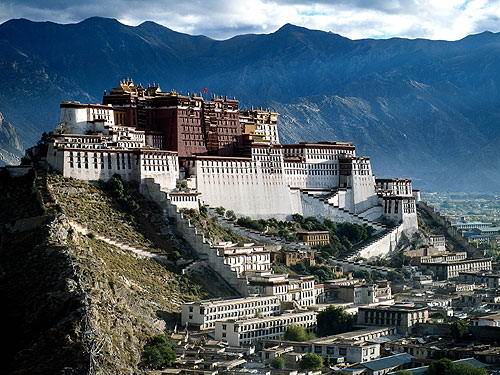Potala Palace in Tibet


The Potala Palace is located in the Red Mountain in the center of Lhasa City. «Potala» is the phonetic adaptation of «Putuo» which in Sanskrit means «island inhabited the Buddha of Mercy». This imposing building was begun in the 7th century, ie at the time of the Tubo Kingdom. At that time it was called Red Monte Palace. When this kingdom went into decline, the palace suffered heavy damage and gradually fell into oblivion. In the 17th century, the Fifth Dalai Lama majestic palace rebuilt and became the political and religious center of Tibet.
With its 13 floors and 110 meters high, is the highest existing old building today in Tibet. Its structure was raised with wood and stone walls, which reach a maximum thickness of 5 meters, are granite, the palace Cimentos sink deep into the rocky soil. On the outer wall, roof and adorned with a gold-colored columns, cast iron was introduced to increase the resistance to earthquakes. At the same time, thereby cleverly solved the problem of how to protect ancient buildings from lightning. The palace was thus able to survive centuries of natural disasters.
The Potala Palace consists of the White Palace, where the Dalai Lama lived, situated in the east, the Red House, in the center, for the recitation of the sutras, the room where the remains of successive Dalai Lama, and the whites of the monks bedrooms, located on the west side. Before the Red Palace, there is a white wall on the great festivals that extends a gigantic Buddhist tapestry portrait of Buddha. This monumental architectural complex was built in stages taking advantage of the terrain with great skill. The result was an imposing and grandiose whose harmonious integration with the environment gives a very high artistic value.

In the Red Palace, which constitutes the main part of the Potala Palace, there are several stupas where the remains of the Dalai Lamas as well as various types of Buddhist halls. The best known and best built pagoda is the Fifth Dalai Lama. From 15 meters high, is divided into three parts: a square base, the tower body and dome. The Fifth Dalai Lama’s remains are preserved with oil and safflower oil in a jug. The body of the pagoda is covered with 3,724 kilos of gold leaf and adorned with over 15,000 diamonds, rubies, emeralds, jadeite, agate and other gemstones.
At the base of the pagoda are exhibited different objects used in religious ceremonies, including musical instruments and chalices. The West Hall, the largest Red Palace is dedicated to the memory of the Fifth Dalai Lama. Its 48 large wooden columns over 6 feet tall. The White Palace structure is supported on arches, very common system among the Han Chinese ethnic majority. In it there are lots of sculptures of Buddha, as well as lions, elephants and other animals, all carved in wood.
In the reconstruction and expansion of the palace in the 17th century made famous painters participated from different regions of Tibet. These brilliant artists decorated with thousands of elegant and beautiful paintings the walls of rooms, hallways, corridors and galleries. The themes of these murals is very rich, encompassing stories about figures of antiquity, stories from the sutras, and specimens of architecture, folk customs, sports and other recreational activities. These works constitute a true artistic treasure. The Potala Palace is also preserved nearly 10,000 valuables.
Besides countless rolls of painting, sculptures in stone and wood, clay figurines and other art objects, abundant cultural relics, including sutras written on sheets of pattra, Tibetan rugs, banners with sutras, porcelain and jade, and various samples of traditional crafts. All this not only has great artistic value, but a translation of the ties that united the Tibetans with Han and other ethnic groups in the country for over a thousand years, and the exchanges they had with them.
Unesco included the Potala Palace in the World Heritage in 1994 and, later, as a supplement, the Jokhang Temple and the Palace of Norbu Lingka.
The construction of the Jokhang Temple, located southeast of Lhasa, began in 601. In Tibetan «Jokhang» means «Buddha more». The main building of this temple is the Hall of Sutras, consists of 4 floors and built in the style have. His columns and eaves, however, are decorated with Tibetan. The murals painted on the walls inside and outside the classroom, as well as the surrounding gallery depicting themes, figures and Buddhist stories. In the Jokhang Temple, against which stands the «Memorial of the union of the Tang Dynasty and the Tubo Kingdom», are kept many relics of great value.
Norbu Lingka which in Tibetan means «precious garden», lies on the banks of the Lhasa River. This palace, whose construction began in the mid 18th century, was the summer residence of the Dalai Lama. It dispatched performing administrative and religious activities. In addition to many beautiful species of trees and flowers, in Norbu Lingka countless relics are kept, codices and old files.
In its assessment of these three places, the World Heritage Committee said its beautiful landscapes, its original architecture and its historical and religious value blend harmoniously to form a fantastic wonder.